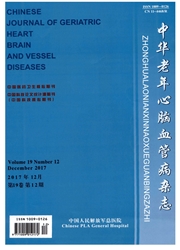

 中文摘要:
中文摘要:
目的探讨脑血管储备能力(cerebrovascular reserve,cVR)与一侧颈内动脉狭窄程度的关系。方法选择脑梗死患者85例,其中颈内动脉狭窄组59例,对照组26例。分别通过吸入5%CO2和95%O2混合气体诱发高碳酸血症,计算大脑中动脉血流速度变化。结果颈内动脉狭窄组患者CVR较对照组明显降低[(22.47±12.45)%vs(37.25±11.77)%,P〈0.01]。cVR与颈内动脉狭窄程度呈负相关(CI=-0.6587,P〈0.01)。颈内动脉狭窄是CVR下降的独立危险因素(OR=5.149,95%CI:2.682~9.858,P〈0.01)。结论颈内动脉狭窄是影响CVR的独立危险因素,检测cVR可能预测颈内动脉狭窄程度。
 英文摘要:
英文摘要:
Objective To study the relation between cerebrovascular reserve(CVR) and unilateral internal carotid artery(ICA) stenosis. Methods Eighty-five patients with cerebral infarction(ineluding 59 patients with ICA stenosis) served as an ICA stenosis group and 26 patients without ICA stenosis served as a control group in this study. Hypercapnia was induced by inhaling 5% CO2 and 95%O2 mixed gas. The blood flow rate in middle cerebral artery was measured. Results The CVR was significantly lower in ICA stenosis group than in control group (22.47%± 12.45% vs 37.25%±11.77% ,P〈0. 01). The CVR was positively correlated with the severity of ICA stenosis(CI=-0. 6587, P〈0.01), indicating that ICA stenosis is an independent factor for the reduced CVR(OR=5.149,95%CI:2. 682--9. 858,P〈0. 01). Conclusion ICA stenosis is an independent factor for CVR and detection of CVR can predict the severity of ICA stenosis.
 同期刊论文项目
同期刊论文项目
 同项目期刊论文
同项目期刊论文
 Tissue kallikrein protects cortical neurons against hypoxia/reoxygenation injury via the ERK1/2 path
Tissue kallikrein protects cortical neurons against hypoxia/reoxygenation injury via the ERK1/2 path Tissue kallikrein preventing the restenosis after stenting of symptomatic MCA atherosclerotic stenos
Tissue kallikrein preventing the restenosis after stenting of symptomatic MCA atherosclerotic stenos 期刊信息
期刊信息
